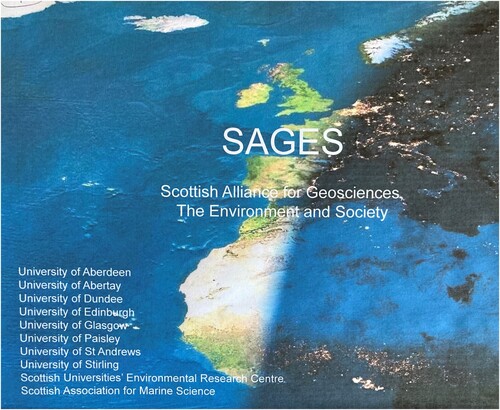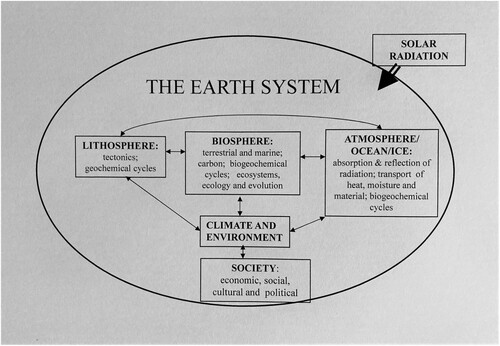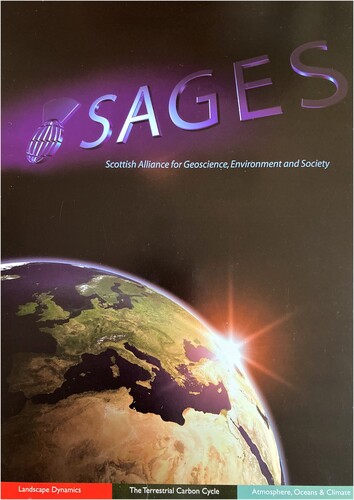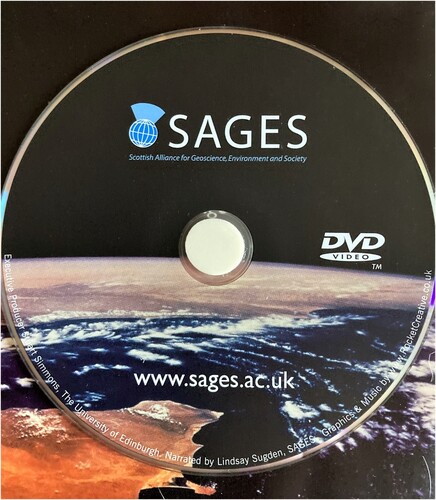ABSTRACT
The Scottish Alliance of Geoscience, Environment and Society (SAGES) was launched in May 2007 and thrives to this day (https://www.sages.ac.uk). It is a major research partnership between ten institutions in Scotland squarely focused on the prime problem of our time, namely understanding how the natural world works and how it interacts with human society. The inspiration driving SAGES is that we can all contribute more if we collaborate. Paul Bishop was a staunch believer in collaboration and played a pivotal role in the building of SAGES. The early history of SAGES and Paul’s contribution is little known and it seems fitting to address this in a special issue in his name.
Introduction
‘Will SAGES be sufficiently international to justify Government expenditure?’ This was the gist of a question from a science assessment committee member at a crucial stage of our negotiations. Paul Bishop took up the challenge and, with his blend of sheer will power and enthusiasm, made a powerful case for just how internationally significant the proposed members of SAGES were, how important it was to tackle climate and environmental change, and how much more we could achieve with collaboration between Scottish universities. Paul was dynamic, using his body and arms expressively, and of course speaking loudly in his broad Australian accent. Any doubts about the international capabilities of SAGES were immediately dismissed!
This, to us, exemplified Paul Bishop in action.
SAGES grew out of collaboration between Paul Bishop at the University of Glasgow, David Sugden at the University of Edinburgh and Tony Fallick at the Scottish Universities Environmental Research Centre (SUERC) which had replaced the nuclear reactor centre (SURRC) in East Kilbride. We worked closely together for the four years 2003–2007. There were numerous meetings and presentations in departments, with university colleagues, other institutions, Principals, financial advisors, and especially with the late David Gani at the Scottish Higher Education Funding Council (SHEFC).
The early history and evolution of SAGES is not well known, records are elusive, and we thought an account would be a fitting tribute to Paul. Above all, Paul stood for collaboration in science and this is what SAGES represents. It is also important to reflect that SAGES continues to play a leading international role in environmental research almost 20 years after it was first conceived (www.sages.ac.uk). We, David and Tony, realise that this account relies on our imperfect personal memories and records, but nevertheless hope that it is of wider interest. What we can be sure of is that Paul would have loved to remember our travails, especially the frequency and surprises of our ups and downs during those four years.
Background
SAGES grew out of several trends affecting the higher education sector in the early 2000s. First, much environmental and earth science was carried out in small departments such as geography, geology, geophysics, environmental science, ecology and these were easily overlooked within individual universities, especially at a time of university funding cuts. Geography departments, particularly those in Social Science faculties, were finding it difficult to fund the resource-intensive aspects of the subject such as physical geography or Geographical Information Systems. Well-resourced geology departments were under pressure to cut costs as student numbers flattened or declined. Biology departments were moving towards medical sciences leaving ecologists somewhat isolated. Partly in response to these pressures, larger geoscience and environmental groupings were emerging in different universities.
Second, it became clear that these groupings could contribute much more to the environmental agenda. For example, at the time the NERC-supported Environment Research Funders Forum was primarily biological in nature and few earth scientists were involved. So here was a clear opportunity for bringing in the environmental skills and perspectives of those in geography and geology departments.
Third, The Scottish Higher Education Funding Council (SHEFC) was exploring new initiatives to counter the absence of fee income from Scottish students. The idea of Pooling resources between universities was one such initiative, and successful but distinctive plans in physics (SUPA) and chemistry (EastChem and WestChem) were approved.
Finally, the value of inter-institutional collaboration had been demonstrated by the success of the Scottish Universities Environmental Research Centre (SUERC), most recently in hosting the NERC UK national cosmogenic isotope facility (CIAF) in East Kilbride. The latter success followed years of collaboration between the universities of Glasgow and Edinburgh in developing the Centre’s facilities and estate. Funding was procured from inter alia the Carnegie Trust for the Universities of Scotland and the Joint Research Equipment Initiative (JREI), and then Fallick, with Mike Summerfield, Paul Bishop and others led a successful first round bid through NERC to the Joint Infrastructure Fund (JIF) for c. £4M for an Accelerator Mass Spectrometry Facility capable of measuring not only 14C but also the in situ-produced cosmogenic isotopes 10Be, 26Al and 36Cl (see e.g. Freeman et al., Citation2003, Citation2007).
Pre-SAGES
The idea of a pooling initiative in earth and environmental science was floated by Geoffrey Boulton at a lecture in Glasgow in 2002/3. He had been involved in the creation of theSHEFC-funded ECOSSE programme, involving petroleum and hydrocarbon reservoir scientists and three institutions in Scotland. Knowing that parallel large-scale pooling arrangements were evolving in other disciplines, we three (Paul, Tony, David) decided to approach SHEFC and explore an initiative.
The first attempt was to try in October 2003 for a grant to build up staff and facilities at SUERC. Our argument was that all extant Scottish universities originally had a stake in SURRC (the forerunner of SUERC) and had access to the facilities. Such an arrangement had the advantage of simplicity and minimal bureaucracy. David Gani at SHEFC was unconvinced and asked if we could evolve pooling in a way that directly benefited a wider spread of institutions across Scotland.
SAGES Mark 1
The next step was submission of SAGES (Scottish Alliance of Geoscience, Environment and Society) Mark 1 in January 2005 (). The submission (the 7th version!) was for £7.16 million over four years and covered the scientific rationale, aims and methods as well as details of governance, management and finance arrangements, the latter ably put together by Dr. Anne Payne.
Figure 1. The introductory slide of SAGES 1, showing the members of the Alliance and purportedly the new dawn over Scotland. It actually shows darkness about to envelope the British Isles!

The rationale had a modern ring and was accompanied by a diagram of the Earth System and society and the two-way links between them ():
All human activity depends on the interaction between the land, oceans, atmosphere and biosphere that compose the Earth System. On the one hand it is the nature of these interactions that determines the environmental state at any given time by controlling climate, ocean currents, sea level, energy resources, food production and water supply. On the other hand, the impact of human activity has reached such a scale that it is changing the Earth System in unexpected ways. Already, construction moves more material each year than all the rivers of the world deliver to the sea, land-use changes have increased the risk of flooding. Demand for water is outstripping supply in many parts of the world, and greenhouse gases in the atmosphere have increased to levels that the Earth has not experienced in the last few million years. Human impacts on natural systems are becoming ever more pervasive, emphasising the need to improve our understanding of these interrelated processes. (SAGES, Citation2005, p. 2)
Figure 2. The initial SAGES view of the Earth System, showing the two-way links between different parts of the natural world and society.

Our preferred mechanism for tackling these problems was to identify four research themes that brought together leading researchers and in which we could claim to have international standing. They were: (1) Quantitative Earth Surface Dynamics, (2) Terrestrial Carbon Cycle and Ecology, (3) Climate and Environmental Change, and (4) Society, Space and the Environment. We were seeking infrastructure support. ‘We seek SHEFC support to facilitate this truly world class centre of excellence by enabling key appointments and the development of essential infrastructure’ (SAGES, Citation2005, p. 1).
Presentation to assessment panel
The 15th of September, 2005 is a day that none of us involved with SAGES or those presenting the themes will forget. It ranks as one of the worst in our careers. We presented our case to an Assessment Panel of some six natural scientists under the impression that, with the encouragement of SHEFC, we were applying for infrastructure support. However, it seemed to us as if the panel had been asked to judge the science itself and had looked at the whole proposal as a single research proposal. Indeed, there were members of NERC Research grant committees represented. All we could do in reply to a series of questions about specific research projects was to insist that the inter-institutional collaborations would lead to novel research proposals and that the support for the running costs of these would be sought from the Research Councils and other appropriate bodies. The committee was also unconvinced by the need for a Society theme. The atmosphere in the room was such that we assumed the whole enterprise must have failed. But we do remember that, before returning to our respective institutions, we agreed with Paul that the best response to rejection was to continue to collaborate, whatever the Assessment Panel said. This was a typical example of Paul’s response to political setback: decide what is best for the scientific community, and formulate a plan to achieve that, circumventing if necessary administrative obstacles.
Later that autumn we received a surprise in the form of a letter from SHEFC asking us to resubmit in early January (2006). The panel’s feedback was more positive than we had expected, but they asked for: (1) clearer articulation of the science case; (2) a re-thinking of how best to link with the needs of society; (3) a more robust management structure; and (4) some revision of resources requirements. Back to the drawing board!
SAGES Mark 2
SAGES Mark 2 (Citation2006, p. 110 pages) sought investment over four years of £22.3 million with around £6.52 million from SHEFC and £15.65 million from the ten institutions involved. The latter reflected a commitment negotiated within individual universities to pick up any posts/facilities after four years.
We refocused the themes and reduced them to three: (1) Landscape dynamics; (2) The terrestrial carbon cycle; (3) Atmosphere, oceans and climate. We added two integrative programmes: (4) Modelling earth system dynamics and (5) Knowledge transfer. The latter was a reframing of the link with society and related more closely to the environmental themes. We rejected a suggestion that we could drop the word Society from the title of the initiative and focus on an environmental ‘SAGE’. In all sections we expanded on the research programmes, giving exemplars. There was particular attention to links with other government-funded science institutions. The knowledge transfer programme was linked to government, policy and economic initiatives. Funding for a dedicated SAGES Director was added to the programme. There was a detailed section on governance and a table of 37 milestones to be reached over four years.
The start
The SHEFC letter of full support arrived on the desks of university Principals on 14th June, 2006 and was warmly received by our various universities, somewhat to our surprise since approval incurred long-term costs for each!
An important milestone was a two-page advertisement in both Nature and Science for 35 SAGES posts across Scotland that appeared in the last week of June (). We advertised for 6 Professors, 18 lectureships, 6 research fellows, 5 technical and computing officers and 18 fully funded research studentships. The advertisement made an impact internationally and Scotland was able to recruit major stars from around the world. We are still in awe of Anne Payne for her remarkable ability to herd Human Resources in nine institutions to approve of a comprehensive advertisement within two weeks of hearing of SHEFC support!
Figure 3. The double page spread of advertisements for 35 posts throughout Scotland that appeared in Nature on 29 June 2006. The advertisement also appeared in Science.

The next milestone was the appointment of Professor Tom Crowley, a distinguished oceanographer and climate scientist from the USA, who became the inaugural Director.
At long last, the official launch of SAGES took place at the Royal Society of Edinburgh on 25th May, 2007. The launch was chaired by Professor Aubrey Manning, a strong SAGES supporter, and included members of the public and a full house of guests from a host of institutions and organisations throughout Scotland. There were welcome talks by Prof Alan Thorpe (Head of NERC), Professor Anne Glover (Chief Scientific Advisor for Scotland), Roger McClure (Scottish Funding Council), Stewart Stevenson, MSP, and the new Director, Professor Tom Crowley. Everyone received a smart brochure that contained a DVD video describing SAGES ( and ).
Lighter moments
There were some lighter memories that it would have pleased Paul to remember. The opening powerpoint slide for our initial presentation listing all the contributing institutions was intended to show a satellite image with a new dawn spreading over Scotland (). Having momentarily forgotten which way the Earth rotates, too late we realised that it was actually showing dusk spreading over Scotland! Perhaps this influenced the Assessment Panel! We made sure that the image on the brochure at the launch did show the new dawn over Scotland ().
Late in the day someone at SHEFC asked about a logo. Help! We had given it no thought at all. We wanted something Scottish but also global. We asked the advertising company VCCP if they could help and they kindly agreed to produce a logo as a training exercise, and thereby free. The resultant image shows the Earth tilted on its axis with a cross section through the atmosphere above. The image can also be seen as a Scottish thistle (). Perfect!
Wider reflections
It is interesting to reflect on the hurdles and tensions during the four years. Sometimes in our negotiation with SHEFC we felt we had agreed a set of goal posts only to find at the next meeting that they had moved. In fairness to SHEFC, they were also learning and exploring how best to develop the Pooling initiative policy and of course they were in touch with other initiatives with other ideas. So, it is only natural that the feedback from the various initiatives was modifying ideas. Below we discuss the main tensions involved: these were generally resolved by inter-institution compromise and by keeping a strong focus on the benefits promised by an eventual successful outcome.
The first and most important was achieving a balance between scientific capability and the scientific research itself. We started by seeking infrastructure development with a bid for support for SUERC. This would have benefited all institutions in Scotland in the environmental (and medical) fields. The problem here for SHEFC was that the Centre was funded mainly by the universities of Glasgow and Edinburgh and that a major grant would not be seen to be benefiting Scottish institutions equitably.
SAGES Mark 1 focused on increasing scientific capability across Scottish institutions, identifying new technical and research posts that would improve collaboration and the exchange of ideas. The rationale was that this would lead to innovative research that was sustainable. Over initial discussions with SHEFC, we felt we had support for this approach. The meeting with the Assessment Panel, that perhaps had been asked to assess the scientific research itself rather than the structure, was a rude shock. Looking back, we can see that SHEFC were also exploring the best way forwards. SAGES Mark 2 included deeper thought about the science and was an improved proposal.
The second major issue was the balance between being elite yet also inclusive. At times during discussions with SHEFC we were urged to ensure that we only included top researchers. At other times the stress was to be inclusive and ensure that more institutions were involved. At one meeting with SHEFC we were surprised to find present a contingent from an as yet uninvolved university. Happily, they became involved with great success. The practical solution to this elite/inclusive balance was finally achieved by inviting any researcher from a SAGES institution who could contribute to the three research themes to apply to join.
A third tension involved the balance between new professors, lecturers, technicians and PhD students. On the whole, SHEFC preferred senior appointments while the contributing departments sought younger researchers and PhD students. Indeed, at one stage the SHEFC view was that the UK research councils already provided research studentships and thus support for PhD students was not part of the Pooling initiative. This view evolved during negotiation, and at the outset we were able to support 18 PhD students. Today in SAGES research students are seen as crucial to the pursuit of innovative research.
A fourth tension concerned the roles of social and natural science. In 2006 climate change was often seen as an environmental issue, and indeed there were some in science who doubted that human activities were linked to global warming. Today in 2022 we know that it is crucial to reduce atmospheric CO2 and we know what changes need to be made. Further, implementation of these changes means we must reorganise the way society works and this is clearly the realm of social science. In retrospect, SAGES Mark 1 was perhaps ahead of the curve in identifying the importance of social science in the study of environmental change, especially to an Assessment Panel of natural scientists. In retrospect we understand why we were recommended to re-think the role of social science theme in the initiative. We were able to rebadge it as an integrative activity under the heading of knowledge transfer.
A fifth tension sometimes arose concerning the roles of universities and other research institutes, for example the British Geological Survey, Scottish Environmental Protection Agency, Centre of Hydrology and the Hutton Institute (formerly Macaulay Land Use Research Institute). To some it appeared as if SAGES was an unnecessary competitor and would duplicate their work. But we argued that the whole point of SAGES was to help individual researchers scattered throughout the university system to bring more to the table and that with SAGES it would be easier to build longer term strategic partnerships between government research institutes and universities.
Conclusion
In late May 2008 approximately two years after the announcement of official SHEFC support, we three, Paul, Tony and David, were asked to reflect at a conference on the value of SAGES. The closing powerpoint slide portrayed the following three bullet points:
Perhaps we have been able to raise the profile of geoscience and its potential within universities, with government and with the public.
Collaboration has caught the imagination of participants (e.g. the high calibre of new staff and research students).
The process of making the bid has shown that it is scientifically and economically efficient to collaborate – and fun!
These final points are a tribute to and a reflection of Paul Bishop’s pivotal role in the creation of SAGES.
Acknowledgements
We are indebted to the many participants within SAGES who contributed to discussions, presentations, refined the main research themes and final version. Particular thanks are due to Sandy Tudhope and John Grace (Edinburgh) and Chris Philo and Trevor Hoey (Glasgow). Their input and enthusiasm was essential over the four years. We also acknowledge the deep interest and advice of the late David Gani at SHEFC. Particular thanks to Anne Payne who did wonders on the technical aspects of the submission, to VCCP for gifting a logo, and to Tracy Dart, Stuart Simmons and Lindsay Sugden for their contribution in the year leading up to the launch. Thanks to two anonymous reviewers for suggestions on the current paper.
Disclosure statement
No potential conflict of interest was reported by the author(s).
References
- Freeman, S., Bishop, P., Bryant, C., Cook, G., Dougans, D., Ertunc, T., Fallick, A., Ganeshram, R., Maden, C., Naysmyth, P., Schnabel, C., Scott, M., Summerfield, M., & Xu, S. (2007). The SUERC AMS laboratory after 3 years. Nuclear Instruments and Methods in Physics Research Section B: Beam Interactions with Materials and Atoms, 259(1), 66–70. https://doi.org/10.1016/j.nimb.2007.01.312
- Freeman, S., Bishop, P., Bryant, C., Cook, G., Fallick, A., Harkness, D., Metcalfe, S., Scott, M., Scott, R., & Summerfield, M. (2003). A new environmental sciences AMS laboratory in Scotland. Nuclear Instruments and Methods in Physics Research B, 223-224, 31–34. doi:10.1016/j.nimb.2004.04.010
- SAGES (1). (2005). Scottish Alliance of Geoscience, Environment and Society, Submitted to SHEFC, 25th January, 2005.
- SAGES (2). (2006). Scottish Alliance of Geoscience, Environment and Society. Submitted to Research Policy & Strategy Directorate, Scottish Funding Council, 12th January, 2006, 110 pp.


